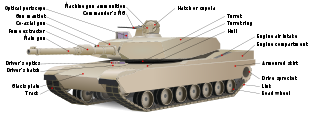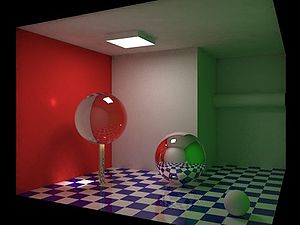بوابة:الرسوم الحاسوبية
| الثقافة | الأعلام والتراجم | الجغرافيا | التاريخ | الرياضيات | العلوم | المجتمع | التقنيات | الفلسفة | الأديان | فهرس البوابات |
Computer graphics includes almost everything on computers that is not text or sound but is normally considered as different from photography. Today almost every computer can do some graphics, and people have come to expect that they will interface with their computer through icons and pictures rather than solely by typing. The term computer graphics has additional meanings:
- the representation and manipulation of pictorial data by a computer
- the various technologies used to create and manipulate such pictorial data
- the images so produced, and
- a sub-field of computer science which studies methods for digitally synthesizing and manipulating visual content.
Today much of our life is affected by computers, and by computer graphics. Whether you see them on television, in newspapers, in weather reports or while at the doctor's surgery, computer images are all around you. A well-chosen graph is able to transform a complex table of numbers into meaningful results. Such graphs are used to illustrate papers, reports, and theses, as well as providing the basis for presentation material in the form of slides and overhead transparencies. A range of tools and facilities are available to enable users to visualise their data, and computer graphics are used in many disciplines.
Global illumination is a general name for a group of algorithms used in 3D computer graphics that are meant to add more realistic lighting to 3D scenes. Such algorithms take into account not only the light which comes directly from a light source (direct illumination), but also subsequent cases in which light rays from the same source are reflected by other surfaces in the scene (indirect illumination).
Theoretically reflections, refractions, and shadows are all examples of global illumination, because when simulating them, one object affects the rendering of another object (as opposed to an object being affected only by a direct light). In practice, however, only the simulation of diffuse inter-reflection or caustics is called global illumination.
Images rendered using global illumination algorithms often appear more photorealistic than images rendered using only direct illumination algorithms. However, such images are computationally more expensive and consequently much slower to generate. One common approach is to compute the global illumination of a scene and store that information with the geometry, i.e., radiosity. That stored data can then be used to generate images from different viewpoints for generating walkthroughs of a scene without having to go through expensive lighting calculations repeatedly.
Radiosity, ray tracing, beam tracing, cone tracing, path tracing, metropolis light transport, ambient occlusion, photon mapping, and image based lighting are examples of algorithms used in global illumination, some of which may be used together to yield results that are fast, but accurate. Find out more...

Scalable vector graphic (SVG) illustration of a tank
Image credit: Doug Hatfield (Dhatfield)
| Concepts and Principles | Image types | Techniques & Tools |
|---|---|---|
|
|
|
|
| Applications | Famous people and images | Related fields |
|
|
|
* Pages with good images
| البوابات الرئيسية: | ||
| قارات: |
آسيا | إفريقيا | اوروبا | الأمريكيتين | |
| دول عربية: |
الجزائر | المغرب | المملكة العربية السعودية | تونس | ليبيا | فلسطين | مصر | | |
| [ بوابة المجتمع ] | [ تصفح البوابات ] |

